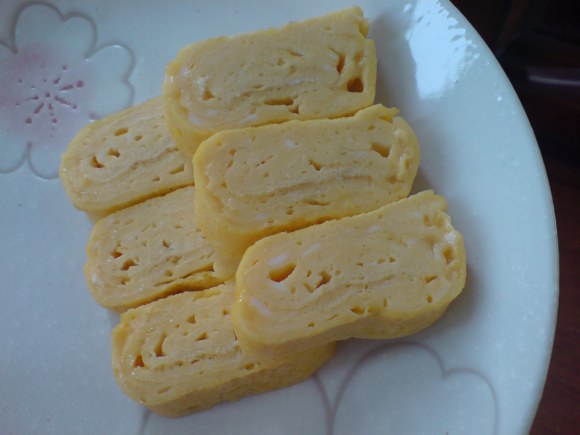
Tamagoyaki (lit. "egg fried") is a Japanese rolled omelette that is popularly eaten for breakfast in Japan, or used as a bento filling. It is also a common sushi topping. Despite it being one of the cheapest types of sushi available, it is also used as the ultimate test of a sushi bar (although apparently many sushi bars now do not make their own tamagoyaki, but serve a pre-made one).
For fans of Japanese food dramas, there is an excellent drama made in 1996 called Shota no Sushi (or King of Sushi), about a young sushi apprentice who dreams of becoming Japan's #1 sushi chef. One episode features his struggles to make the perfect tamagoyaki that is springy enough that it can bend in a U-shape without breaking.
There are many different tamagoyaki recipes. Some are sweet, others salty. Some add dashi (a Japanese stock made by boiling kombu (kelp) and katsuobushi (dried bonito flakes)), and others mirin (Japanese rice wine). My preference is to add mirin but not dashi, and I skip the sugar as eggs for me should taste savoury. Sometimes if I'm in a rush, I'll skip the mirin as well, and just make a plain soya sauce version... In other words, my tamagoyaki is not a traditional Japanese one, but rather a rolled omelette, but hey, it still tastes good...
Continue reading...
How to Make Tamagoyaki
Tamagoyaki is usually made in a rectangular shaped frying pan, but if you don't have one (like me), you can use a small, round, non-stick frying pan.
2 large eggs
sprinkle of sugar (if you want it sweet)
1/2 tsp mirin
1/4 tsp soya sauce
light olive oil (or other cooking oil)
1. Mix the eggs, sugar, mirin and soya sauce together lightly.
2. Pour a small amount of oil (approx 1 tsp) into a small non-stick frying pan and swirl it around with a spatula to coat the bottom. Heat up the pan on low heat.
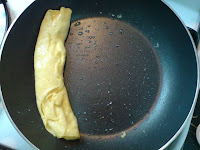
3. Pour 1/3 of the egg mixture into the frying pan and swirl the pan around so the egg coats the base evenly. When the egg is half-cooked, carefully move the spatula around the edge of the circle of egg to loosen the egg from the pan. Starting at one edge, fold/roll the egg over and over until it has reached the other side of the pan.
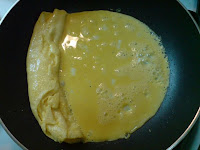
4. Pour 1/2 of the remaining egg mix into the pan beside the rolled egg. Some people coat the pan with more oil before pouring more egg in - do this if you need to, but I find my non-stick pan doesn't require more oil (you can see there are enough drops of oil in the above photo). Lift up the rolled egg to allow the raw egg mix to flow underneath it.
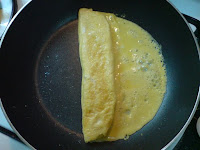
5. Beginning at the edge of the rolled egg, fold/roll it over the half-cooked egg until all the egg has been rolled up. (ie. in the photo, the egg is being rolled from left to right.)
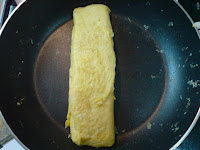
6. Repeat steps 4. and 5. with the remainder of the raw egg mix. ie. pour the egg mix into the pan next to the rolled egg, and lift the rolled egg up to allow the raw egg to flow underneath it. Starting at the edge of the rolled egg, roll it back to the other side.

7. Cook for a little longer, then remove from the pan. If you are using a round pan, you may wish to reshape the tamagoyaki at this point. Using a bamboo rolling mat, put the warm tamagoyaki on the mat and roll it up or shape it accordingly. Cool, then slice. If you don't want to shape it, it will turn out rectangular with rounded edges (as in the photo).
Update: If you find yourself making tamagoyaki regularly, you may wish to invest in a small, rectangular shaped non-stick pan. I picked one up at a cheap price, and it has been really handy.




3 comments:
Just so you know - I posted about this entry on my blog.
Thanks very much :) Hope it works out well for you.
Thanks! I've succeeded making one! The step-by-step pics are perfect!
Thanks again!
Post a Comment